Eggs as food
In 2009, an estimated 62.1 million metric tons of eggs were produced worldwide from a total laying flock of approximately 6.4 billion hens.The chicken was most likely domesticated for its eggs (from jungle fowl native to tropical and subtropical Southeast Asia and Indian subcontinent) before 7500 BCE.Eggs scrambled with acidic fruit juices were popular in France in the seventeenth century; this may have been the origin of lemon curd.[8] The production of dried eggs significantly expanded during World War II, for use by the United States Armed Forces and its allies.Eggs are a common everyday food in many parts of Asia, such as China and Thailand, with Asian production providing 59 percent of the world total in 2013.[19] Eggshell color is caused by pigment deposition during egg formation in the oviduct and may vary according to species and breed, from the more common white or brown to pink or speckled blue-green.The primary natural purpose of egg white is to protect the yolk and provide additional nutrition during the growth of the embryo.[40] Chilling an overcooked egg for a few minutes in cold water until it is completely cooled may prevent the greenish ring from forming on the surface of the yolk.[7] For example, when a brown-egg chicken breed eats rapeseed (canola) or soy meals, its intestinal microbes metabolize them into fishy-smelling triethylamine, which ends up in the egg.Another method is to make pickled eggs, by boiling them first and immersing them in a mixture of vinegar, salt, and spices, such as ginger or allspice.[49] This chemical process breaks down some of the complex, flavorless proteins and fats of the yolk into simpler, flavorful ones, which in some way may be thought of as an "inorganic" version of fermentation.[52][53] Due to their protein content, the United States Department of Agriculture formerly categorized eggs as Meat within the Food Guide Pyramid (now MyPlate).For instance, chicken eggs that are especially high in omega-3 fatty acids are produced by feeding hens a diet containing polyunsaturated fats from sources such as fish oil, chia seeds, or flaxseeds.[56] Pasture-raised free-range hens, which forage for their own food, also produce eggs that are relatively enriched in omega-3 fatty acids when compared to those of cage-raised chickens.A meta-analysis from 2013 found that eating four eggs per week was associated with a 29 percent increase in the relative risk of developing diabetes.[67] A 2016 meta-analysis suggested that association of egg consumption with increased risk of incident type 2 diabetes may be restricted to cohort studies from the United States.[71] A 2019 meta-analysis found an association between high egg consumption and risk of upper aero-digestive tract cancers in hospital-based case-control studies.[77] A 2018 meta-analysis of randomized clinical trials found that consumption of eggs increases total cholesterol (TC), LDL-C and HDL-C compared to no egg-consumption but not to low-egg control diets.[79][80] A 2020 umbrella review concluded that increased egg consumption is not associated with cardiovascular disease risk in the general population.[94] A 2021 review of clinical trials found that egg consumption has beneficial effects on macular pigment optical density and serum lutein.Fertile eggs will not contain a developed embryo, as refrigeration temperatures inhibit cellular growth for an extended period of time.In Australia[107] and the European Union, eggs are graded by the hen raising method, free range, battery caged, etc.[114] Research conducted by a French institute in the 1970s demonstrated blue chicken eggs from the Chilean araucana fowl may be stronger and more resilient to breakage.[117] Commercial factory farming operations often involve raising the hens in small, crowded cages, preventing the chickens from engaging in natural behaviors, such as wing-flapping, dust-bathing, scratching, pecking, perching, and nest-building.[118] Many hens confined to battery cages, and some raised in cage-free conditions, are debeaked to prevent them from harming each other and engaging in cannibalism.[123] The United Egg Producers program includes guidelines regarding housing, food, water, air, living space, beak trimming, molting, handling, and transportation, however, opponents such as The Humane Society have alleged UEP certification is misleading and allows a significant amount of unchecked animal cruelty.[125][126] Effective 1 January 2012, the European Union banned conventional battery cages for egg-laying hens, as outlined in EU Directive 1999/74/EC.In all methods of egg production, unwanted male chicks are killed at birth during the process of securing a further generation of egg-laying hens.Before the spring equinox in the Persian New Year tradition (called Norouz), each family member decorates a hard-boiled egg and they set them together in a bowl.[135] Since the sixteenth century, the tradition of a dancing egg is held during the feast of Corpus Christi in Barcelona and other Catalan cities.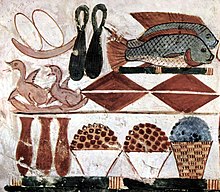

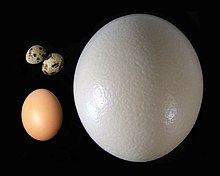
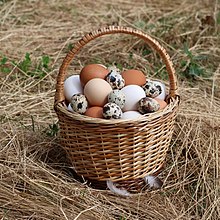


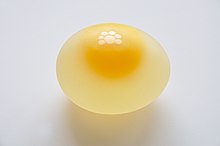

- Eggshell
- Outer membrane
- Inner membrane
- Chalaza
- Exterior albumen
- Middle albumen
- Vitelline membrane
- Nucleus of Pander
- Germinal disc (nucleus)
- Yellow yolk
- White yolk
- Internal albumen
- Chalaza
- Air cell
- Cuticula












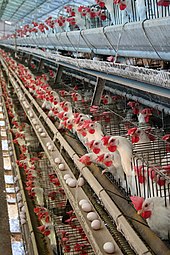

Chicken or the eggEgg (disambiguation)Egg predationchickensostrichesreptilesamphibianscaviarmass productionmetric tonsEuropean Unionbattery husbandrytomb of MennaprehistoryIndian subcontinentGreeceThebes, Egyptostrich eggspelicanancient RomeRomansMiddle AgesFrancelemon curdSt. Louis, Missouridried eggsWorld War IIegg cartonSmithers, British ColumbiaBulkley ValleyPolystyrenebiodegradableostrichingredientsfood industrychickenquail eggsThailandGull eggsEnglandNorwayguineafowlPheasanttonnesUrner Barrycandledcommon misconceptionegg boxesEgg (biology)vinegarEggshellChalazaalbumenVitelline membraneGerminal discCuticulaegg whiteegg yolkthin membraneschalazaeprolate spheroidcandlingpigmentoviductspeciesprotoporphyrin IXbiliverdinchicken breedsEggshell membraneproteinscollagentype Iembryoalbuminsmucoproteinsglobulinslipidscarbohydratevaccinesthose for influenzapigmentsxanthophyllsLuteinmarigoldegg drop syndromeList of egg dishesScrambled eggsbaked goodsscrambledpoachedhard-boiledomelettespickledsalmonellosisbioavailableemulsifiercustardsmeringuesmoussefood additivecalciumgaletteseggs may be pasteurizedsulfurtea eggsrapeseedtriethylamineSalmonellabacteriafood poisoningsalted duck eggosmotic equilibriumcongeemooncakespickled eggsgingerallspicebeetrootcalcium carbonateacidicCentury eggwood ashalkalinefermentationEnergyCarbohydrates

